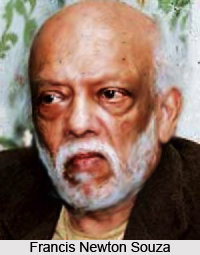 Francis Newton Souza was born on April 12, 1924, in Saligoa, Goa. His work is in major museum collections around the world including the Tate. He initially attended St. Xavier`s College in Bombay however was expelled. He studied at the Sir J. J. School of Art, but was suspended in 1945 as he had lent his support to the Quit India Movement. Thereafter he and many other artists founded the Bombay Progressive Artists` Group.
Francis Newton Souza was born on April 12, 1924, in Saligoa, Goa. His work is in major museum collections around the world including the Tate. He initially attended St. Xavier`s College in Bombay however was expelled. He studied at the Sir J. J. School of Art, but was suspended in 1945 as he had lent his support to the Quit India Movement. Thereafter he and many other artists founded the Bombay Progressive Artists` Group.
However, in 1949, after India became independent, he left the country for London. In early 1950`s he started getting recognition for his works at Gallery One, North London. The Institute of Contemporary Arts included work of his in a 1954 exhibition, and other shows followed. His literary talents also helped his career after the publication of the autobiographical work Nirvana of a Maggot in Encounter, a journal then edited by Stephen Spender. His book Words and Lines published 1959 cemented his literary reputation.
His style was deliberately diverse, essentially Expressionist in character as well as depicted the post-war Art Brut movement and elements of British Neo-romanticism. He settled in New York after 1967 but returned before his death. Souza was one of the early modernist in the true sense of the term. His painting always screamed to make the world his own. His appeared short-lived. His paintings seemed grave and futile as if mocking at the viewer. He reasserted the intensity of impressions with utmost desperation. His painting seemed to attack the canvas as if he waged a war against it. He combined the art of expressionism of Rouault and Soutine, fortitude of Cubism and ancient Indian classical sculptures. Lines were his forte. His paintings were mysterious and captivating.
His autobiographical essay `Nirvana of a Maggot` which appeared in 1955 in a magazine edited by Stephen Spender made him famous. `Words and Lines` was his other great book which was published in London in 1959. In 1967, Souza settled in New York. He has also participated in several other exhibitions which include one-man shows in Paris in 1954 and 1960 and in Detroit in 1968. In 1987, his retrospectives were held in New Delhi and Mumbai. Souza`s work had hints of expressionism and British neo-romanticism.
In his last days Francis Newton Souza painted many pictures under the title "Goa portfolio" where he also wrote a lot of inspiring prose. He was always viewed as a brilliant painter, a good writer, a visionary and a pathfinder.



















